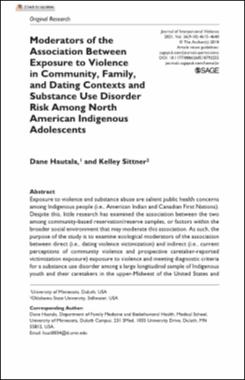| dc.contributor.author | Hautala, Dane | |
| dc.contributor.author | Sittner, Kelley | |
| dc.date.accessioned | 2022-05-31T18:49:59Z | |
| dc.date.available | 2022-05-31T18:49:59Z | |
| dc.date.issued | 2021-05 | |
| dc.identifier | oksd_sittner_moderatorsoftheassociation_2021 | |
| dc.identifier.citation | Hautala, D., & Sittner, K. (2021). Moderators of the association between exposure to violence in community, family, and dating contexts and substance use disorder risk among North American Indigenous adolescents. Journal of Interpersonal Violence, 36(9-10), pp. 4615-4640. https://doi.org/10.1177/0886260518792255 | |
| dc.identifier.uri | https://hdl.handle.net/11244/335846 | |
| dc.description.abstract | Exposure to violence and substance abuse are salient public health concerns among Indigenous people (i.e., American Indian and Canadian First Nations). Despite this, little research has examined the association between the two among community-based reservation/reserve samples, or factors within the broader social environment that may moderate this association. As such, the purpose of the study is to examine ecological moderators of the association between direct (i.e., dating violence victimization) and indirect (i.e., current perceptions of community violence and prospective caretaker-reported victimization exposure) exposure to violence and meeting diagnostic criteria for a substance use disorder among a large longitudinal sample of Indigenous youth and their caretakers in the upper-Midwest of the United States and Canada (N = 521). Data come from the last two waves of the study, when the adolescents were between the ages of 16 and 19 years. The results show relatively high rates of direct and indirect violence exposure by late adolescence. Logistic regression models with added interaction terms were examined to test moderating effects. Per capita family income and remote location both amplified the positive association between current community violence exposure and substance use disorder risk. Family warmth and support buffered the association between caretaker victimization exposure and substance use disorder risk, whereas dating violence victimization exposure amplified this association. The findings are contextualized for Indigenous communities, and substance abuse prevention and intervention implications are discussed. | |
| dc.format | application/pdf | |
| dc.language | en_US | |
| dc.publisher | SAGE Publications | |
| dc.relation.ispartof | Journal of Interpersonal Violence, 36 (9-10) | |
| dc.relation.uri | https://www.ncbi.nlm.nih.gov/pubmed/30084292 | |
| dc.rights | This material has been previously published. In the Oklahoma State University Library's institutional repository this version is made available through the open access principles and the terms of agreement/consent between the author(s) and the publisher. The permission policy on the use, reproduction or distribution of the material falls under fair use for educational, scholarship, and research purposes. Contact Digital Resources and Discovery Services at lib-dls@okstate.edu or 405-744-9161 for further information. | |
| dc.subject.mesh | Adolescent | |
| dc.subject.mesh | Adult | |
| dc.subject.mesh | Canada | |
| dc.subject.mesh | Crime Victims | |
| dc.subject.mesh | Exposure to Violence | |
| dc.subject.mesh | Humans | |
| dc.subject.mesh | Prospective Studies | |
| dc.subject.mesh | Substance-Related Disorders | |
| dc.subject.mesh | United States | |
| dc.subject.mesh | Violence | |
| dc.subject.mesh | Young Adult | |
| dc.title | Moderators of the association between exposure to violence in community, family, and dating contexts and substance use disorder risk among North American Indigenous adolescents | |
| dc.date.updated | 2022-05-31T14:35:54Z | |
| osu.filename | oksd_sittner_moderatorsoftheassociation_2021.pdf | |
| dc.description.peerreview | Peer reviewed | |
| dc.identifier.doi | 10.1177/0886260518792255 | |
| dc.description.department | Sociology | |
| dc.type.genre | Article | |
| dc.type.material | Text | |
| dc.subject.keywords | American Indian | |
| dc.subject.keywords | First Nations | |
| dc.subject.keywords | substance abuse | |
| dc.subject.keywords | victimization | |
| dc.subject.keywords | violence | |
| dc.subject.keywords | Drug Abuse (NIDA Only) | |
| dc.subject.keywords | Injury - Childhood Injuries | |
| dc.subject.keywords | Pediatric Research Initiative | |
| dc.subject.keywords | Behavioral and Social Science | |
| dc.subject.keywords | Violence Research | |
| dc.subject.keywords | Youth Violence Prevention | |
| dc.subject.keywords | Violence Against Women | |
| dc.subject.keywords | Clinical Research | |
| dc.subject.keywords | Youth Violence | |
| dc.subject.keywords | Injury (total) Accidents/Adverse Effects | |
| dc.subject.keywords | Pediatric | |
| dc.subject.keywords | Prevention | |
| dc.subject.keywords | Mental Health | |
| dc.subject.keywords | 2.3 Psychological, social and economic factors | |
| dc.subject.keywords | 16 Peace, Justice and Strong Institutions | |
| dc.subject.keywords | 3 Good Health and Well Being | |
| dc.subject.keywords | 1602 Criminology | |
| dc.subject.keywords | 1607 Social Work | |
| dc.subject.keywords | 1701 Psychology | |
| dc.subject.keywords | Criminology | |
| dc.relation.oaversion | Accepted version | |
| dc.relation.oaurl | https://www-ncbi-nlm-nih-gov.argo.library.okstate.edu/pmc/articles/PMC6367061/ | |
| dc.identifier.author | ScopusID: 57193600395 (Hautala, D) | |
| dc.identifier.author | ORCID: 0000-0002-8588-4487 (Sittner, K) | |
| dc.identifier.author | ScopusID: 55189348500 (Sittner, K) | |
